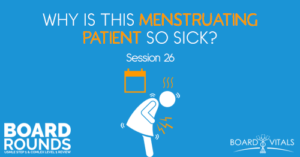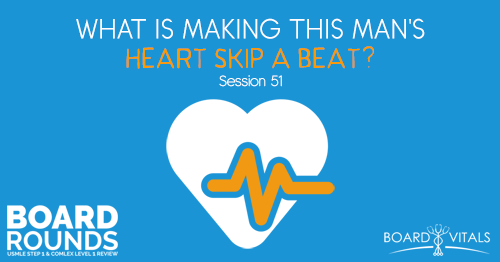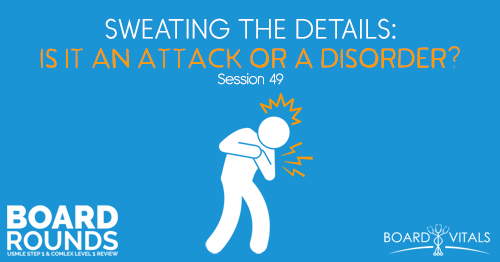Apple Podcasts | Google Podcasts

Session 26
A 20-year-old menstruating adult is tachycardic, somnolent, and hypotensive with GI symptoms and macular rash. What sort of organism do you suspect?
As always, we’re joined by Dr. Karen Shackelford from BoardVitals.
Listen to this podcast episode with the player above, or keep reading for the highlights and takeaway points.
[01:35] Question of the Week
A 20-year-old female patient presents 5th day of her menstrual period complaining about abdominal pain, vomiting, watery diarrhea, and myalgia for 12 hours. On exam, her temperature is 103.13 F. Her blood pressure is 80/60 mm/Hg. And her heart rate is 135 beats per minute.
She is ill-appearing, somewhat somnolent, has hyperemic 02:04 and a generalized erythematous macular rash that involves her palms and soles. Which of the following best describes the cause of her illness?
(A) Gram-negative diplococci
(B) Gram-negative obligate intracellular bacteria
(C) Gram-positive facultative anaerobic cocci
(D) Single positive stranded RNA virus
[Related episode: Biology Grab Bag of Questions for the MCAT]
[02:50] Thought Process Behind the Correct Answer
The correct answer here is C. The patient has toxic shock syndrome. It didn’t mention in the question but she had an indwelling tampon.
Highly absorbent tampons are the biggest risk factor. But interestingly, half of the women who develop toxic shock syndrome during the menstrual period are not using tampons actually.
Related to the menstrual period, however, a toxic shock is usually the result of infection by Staphylococcus aureus. It releases endotoxins. But also, 05:33 axis is superantigen. And that’s what triggers the syndrome. It triggers the activation of T-lymphocyte and they release massive amounts of cytokine.
The post-immune response is limited in patients with toxic shock. Studies show that people who end with toxic shock, they failed to develop an antibody against the bacteria that usually developed in up to 95% of the population in childhood.
The criteria for diagnosis include fever, chills, hypotension, and dermatologic findings. Evident multi-system organ involvement is at least 3 body systems and that counts the skin.
In this patient’s case, she had her circulatory system. She had hyperemia of her mucus membranes. The maculopapular rash would eventually desquamate after 1-2 weeks.
She had nausea, vomiting, diarrhea in the GI system. Her mental status was somnolent. Some people have seizures from somnolence or encephalopathy that the other organ involvement may include intrinsic renal failure or prerenal failure.
Myalgias are also sometimes resolved in elevated serum creatinine phosphokinase. hepatic dysfunction is also not uncommon.
[07:50] The Treatment
If there’s foreign body removal, the treatment of any surgical wounds is the rapid administration of appropriate antibiotics. This includes Vancomycin and Clindamycin with the Penicillin that has B-lactamase inhibitor.
[08:10] Understanding the Wrong Answer Choices
You would probably suspect meningococcal meningitis but then you would have thought they would have given you a clue about the stiff neck. Rocky Mountain spotted fever for answer choice B would also be a good thought.
The USMLE Step 1 is going to give you clues to the most typical case. For instance, with Rocky Mountain spotted fever, they would probably mention that the patient was in an endemic area. But they wouldn’t necessarily say he was bitten by a mosquito.
Finally, Dengue fever is the diagnosis for answer choice D.
'Keep your eyes open for clues.'Click To TweetRemember that they’re not going to hand-feed you every single detail. It’s not always going to be that easy.
[11:00] BoardVitals
Check out BoardVitals‘ USMLE Step 1 QBank or their COMLEX Level 1 QBank. They have 1-month, 3-month, and 6-month packages. Every time you purchase, a vaccine is donated.
If you get the 3-month or 6-month package, they offer the Ask a Clinician feature where you can respond to a question. Then one of the physicians from BoardVitals will respond to you as well. Use the promo code BOARDROUNDS to save 15% off.
Links:
BoardVitals (promo code: BOARDROUNDS to save 15% off)
SEARCH SITE
LISTEN FOR FREE











